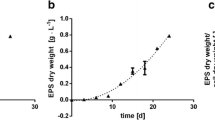Abstract
This is the first demonstration of process scale-up of a membrane gradostat reactor for continuous enzyme production using Phanerochaete chrysosporium ME446. The fungus was immobilised by reverse filtration on to externally unskinned, ultrafiltration capillary membranes and then nutrient gradients were induced across the biofilm. A 10-fold scale-up from a single capillary bioreactor to a 2.4 l multi-capillary unit resulted in a 7-fold increase in enzyme productivity with a peak at 209 U l−1 d−1. Subsequent scale effects on the spore distribution, continuous manganese peroxidase production profile and biofilm development are discussed.
Similar content being viewed by others
References
Aitken MD, Irvine RL (1990) Characterisation of reactions catalysed by P. chrysosporium. Arch. Biochem. Biophys. 276: 405–414.
Barr DP, Aust SD (1994) Mechanisms white rot fungi use to degrade pollutants. Environ. Sci. Technol. 28: 78A–87A.
Bosco F, Ruggeri B, Sassi G (1996) Experimental identification of a scalable reactor configuration for lignin peroxidase production by P. chrysosporium. J. Biotechnol. 52: 21–29.
Couto SR, Feijoo G, Moriera MT, Lema JM (2002) Evaluation of the environmental conditions for the continuous production of lignin peroxidase by P. chrysosporium in fixed-bed reactors. Biotechnol. Lett. 24: 791–794.
Dominguez A, Rivela I, Couto SR, Sanroman A (2001) Design of a new rotating drum bioreactor for ligninolytic enzyme production by P. chrysosporium grown on an inert enzyme support. Process Biochem. 37: 549–554.
Gerin P, Bellon-Fontaine MN, Asther M, Rouxhet PG (1995) Immobilisation of fungal spores by adhesion. Biotechnol. Bioeng. 47: 677–687.
Jacobs EP, Leukes WD (1996) Formation of an externally unskinned polysulphone capillary membrane. J. Mem. Sci. 121: 149–157.
Jacobs EP, Botes JP, Bradshaw SM, Saayman HM (1997) Ultra-filtration in potable water production. Water South Africa 23: 1-6.
Linko S (1992) Production of P. chrysosporium lignin peroxidase. Biotechnol. Adv. 10: 191–236.
Moreira MT, Palma C, Feijoo G, Lema JM (1998) Strategies for the continuous production of ligninolytic enzymes in fixed and fluidised bed bioreactors. Enzyme Microb. Tech. 13: 727–733.
Pal N, Lewandowski G, Armenante PM(1995) Process optimisation and modelling of trichlorophenol degradation by P. chrysosporium. Biotechnol. Bioeng. 46: 599–609.
Tien M, Kirk TK (1988) Lignin peroxidases of P. chrysopsorium. Meth. Enzymol. 161: 238–252.
Venkatadri R, Irvine RL (1993) Cultivation of P. chrysosporium and production of lignin peroxidase in novel biofilm reactor systems: hollow fiber reactor and silicone membrane reactor. Water Res. 27: 591–596.
Author information
Authors and Affiliations
Corresponding author
Rights and permissions
About this article
Cite this article
Govender, S., Jacobs, E., Leukes, W. et al. A scalable membrane gradostat reactor for enzyme production using Phanerochaete chrysosporium . Biotechnology Letters 25, 127–131 (2003). https://doi.org/10.1023/A:1021963201340
Issue Date:
DOI: https://doi.org/10.1023/A:1021963201340




